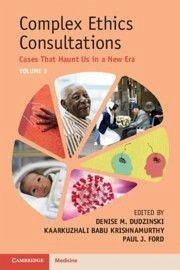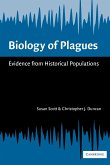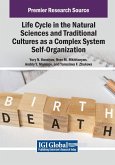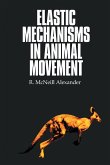Complex Ethics Consultations: Volume 2
Cases That Haunt Us in a New Era
Herausgeber: Dudzinski, Denise M.; Ford, Paul J.; Krishnamurthy, Kaarkuzhali Babu
Complex Ethics Consultations: Volume 2
Cases That Haunt Us in a New Era
Herausgeber: Dudzinski, Denise M.; Ford, Paul J.; Krishnamurthy, Kaarkuzhali Babu
- Broschiertes Buch
- Merkliste
- Auf die Merkliste
- Bewerten Bewerten
- Teilen
- Produkt teilen
- Produkterinnerung
- Produkterinnerung
The second volume offers dozens of new haunting ethics cases describing ethical complexities confronted by patients, families, and clinicians. Chapters describe the emotional and humanistic aspects of the practice of clinical ethics with cases written in accessible language suitable for clinicians and bioethicists at all stages of their careers.
Andere Kunden interessierten sich auch für
![Biology of Plagues Biology of Plagues]() Susan ScottBiology of Plagues65,99 €
Susan ScottBiology of Plagues65,99 €![Adaptive Dynamics of Infectious Diseases Adaptive Dynamics of Infectious Diseases]() Ulf Dieckmann / Johan A. J. Metz / Maurice W. Sabelis / Karl Sigmund (eds.)Adaptive Dynamics of Infectious Diseases69,99 €
Ulf Dieckmann / Johan A. J. Metz / Maurice W. Sabelis / Karl Sigmund (eds.)Adaptive Dynamics of Infectious Diseases69,99 €![Biology and the Foundations of Ethics Biology and the Foundations of Ethics]() Biology and the Foundations of Ethics43,99 €
Biology and the Foundations of Ethics43,99 €![Life Cycle in the Natural Sciences and Traditional Cultures as a Complex System Self-Organization Life Cycle in the Natural Sciences and Traditional Cultures as a Complex System Self-Organization]() Yury N. KovalyovLife Cycle in the Natural Sciences and Traditional Cultures as a Complex System Self-Organization227,99 €
Yury N. KovalyovLife Cycle in the Natural Sciences and Traditional Cultures as a Complex System Self-Organization227,99 €![A Study in Professional Ethics A Study in Professional Ethics]() Gaylen A. ThurstonA Study in Professional Ethics17,99 €
Gaylen A. ThurstonA Study in Professional Ethics17,99 €![The Mysterious Commonplace The Mysterious Commonplace]() Delisi CharlesThe Mysterious Commonplace27,99 €
Delisi CharlesThe Mysterious Commonplace27,99 €![Elastic Mechanisms in Animal Movement Elastic Mechanisms in Animal Movement]() R. McNeill AlexanderElastic Mechanisms in Animal Movement57,99 €
R. McNeill AlexanderElastic Mechanisms in Animal Movement57,99 €-
-
-
The second volume offers dozens of new haunting ethics cases describing ethical complexities confronted by patients, families, and clinicians. Chapters describe the emotional and humanistic aspects of the practice of clinical ethics with cases written in accessible language suitable for clinicians and bioethicists at all stages of their careers.
Produktdetails
- Produktdetails
- Verlag: Cambridge University Press
- Seitenzahl: 259
- Erscheinungstermin: 31. Dezember 2025
- Englisch
- ISBN-13: 9781009400909
- ISBN-10: 1009400908
- Artikelnr.: 74872833
- Herstellerkennzeichnung
- Libri GmbH
- Europaallee 1
- 36244 Bad Hersfeld
- gpsr@libri.de
- Verlag: Cambridge University Press
- Seitenzahl: 259
- Erscheinungstermin: 31. Dezember 2025
- Englisch
- ISBN-13: 9781009400909
- ISBN-10: 1009400908
- Artikelnr.: 74872833
- Herstellerkennzeichnung
- Libri GmbH
- Europaallee 1
- 36244 Bad Hersfeld
- gpsr@libri.de
Introduction; Part I. Perinatal Dilemmas: 1. God's telling me I can't trust
you Kathy Johnson Neely; 2. High stakes, time pressure, and inadequate
information: balancing risks in labor and delivery Annette Mendola; 3.
Balancing autonomy and interdependence: ethical considerations in shared
decision making and reproductive rights Jennifer M. Wimbley and Teresa
Ellis; 4. Dying Together: a pandemic story Eli Weber; Part II. From
Childhood to Adulthood: 5. Reasoning from faith or fact Elizabeth Lanphier
and Joseph Fanning; 6. Overriding parental authority for a dying adolescent
Ann Kessler and Olubukunola M. Dwyerage; 7. Can medicine fix a broken
story? When a broken body is only part of the tragedy Joel Wu, Justin Penny
and Jaime Konerman-Sease; 8. When we commit harm by omission: failing our
most vulnerable Jessie Roske and Peter Bauck; Part III. Neurodiversity,
Disability, and Respect: 9. The noble intent of clinicians and the
limitations of substituted judgment in deciding for others Liz Blackler;
10. Silenced Bridget Carney; 11. It could have been me Emma J. Kagel; 12.
Excluded from society: whose job is it to care (if not mine)? Elizabeth
Sivertsen; Part IV. End of Life (EOL) Decision-Making: Variations on a
Theme: 13. No communication, no collaboration, no trust Patricia A. Mayer;
14. Keep on keeping on? Erin Paquette, Joel Frader and Angira Patel; 15.
Locked in Marion Danis; 16. The legacy of social determinants in a question
of non-beneficial interventions Kristin Furfari; Part V. Hi-Tech Devices
and Techniques: Challenging Paradigms: 17. Is she being doubly victimized?
Vulnerabilities in LVAD eligibility Laura Guidry-Grimes and Evan DeRenzo;
18. Really, most sincerely dead? The challenge of declaring circulatory
death on VA ECMO M. Jeanne Wirpsa; 19. Who controls the medical technology
placed in our bodies? Maggi A. Budd and Rod Dismukes; 20. Who says it is a
bridge to nowhere? Louis Voigt and Amy E. Scharf; 21. I will just go home
and die Paul Ford; Part VI. Pandemic and Rural Context: 22. ECMO in the
Covid-19 pandemic: weighing conflicting duties in the face of scarcity and
vulnerability Kelly Turner, Jordan Potter and Jason Lesandrini; 23. Well
beyond rural: Alaska, Alaskan culture, and medicine Mark F. Carr; 24.
Cultural differences, misalignment, and moral distress Don C. Postema and
Marlane J. Brown; 25. When a fight for life initiates a search for trust
Laura B. Webster; Part VII. Complex Admissions, Stays, and Discharges: 26.
Doing it to themselves: can repeated foreign body ingestion provide us
ethical considerations for repeated self harm? Sara Kolmes, Kayla Tabari
House and L. McLean House II; 27. Withholding food to save a life: safe
medical care or human rights violation? Can it be both? Heidi Funke and
Bryan Gish; 28. Relentless debridement: responding to moral distress
provoked by non-beneficial surgical intervention Lauren Sankaray and
Georgina Morley; 29. What's in a name? Kaarkuzhali Babu Krishnamurthy; Part
VIII. Organizational Ethics Issues: 30. Disability, dignity, and risk of
death: who decides? Lori Eckel and Celeste Weber; 31. Balancing facts and
feelings: when patient rights and employee safety collide Katie DiDomenico,
Lyla Correoso-Thomas and Yelena Zatulovsky; 32. Off the hook? TA-NRP and
the pressures of organ procurement Denise Dudzinski and James N.
Kirkpatrick; 33. When institutional and personal conscience collide:
navigating trauma exposure and dual roles as an ethics consultant Andrea
Frolic; Concluding Remarks; Index.
you Kathy Johnson Neely; 2. High stakes, time pressure, and inadequate
information: balancing risks in labor and delivery Annette Mendola; 3.
Balancing autonomy and interdependence: ethical considerations in shared
decision making and reproductive rights Jennifer M. Wimbley and Teresa
Ellis; 4. Dying Together: a pandemic story Eli Weber; Part II. From
Childhood to Adulthood: 5. Reasoning from faith or fact Elizabeth Lanphier
and Joseph Fanning; 6. Overriding parental authority for a dying adolescent
Ann Kessler and Olubukunola M. Dwyerage; 7. Can medicine fix a broken
story? When a broken body is only part of the tragedy Joel Wu, Justin Penny
and Jaime Konerman-Sease; 8. When we commit harm by omission: failing our
most vulnerable Jessie Roske and Peter Bauck; Part III. Neurodiversity,
Disability, and Respect: 9. The noble intent of clinicians and the
limitations of substituted judgment in deciding for others Liz Blackler;
10. Silenced Bridget Carney; 11. It could have been me Emma J. Kagel; 12.
Excluded from society: whose job is it to care (if not mine)? Elizabeth
Sivertsen; Part IV. End of Life (EOL) Decision-Making: Variations on a
Theme: 13. No communication, no collaboration, no trust Patricia A. Mayer;
14. Keep on keeping on? Erin Paquette, Joel Frader and Angira Patel; 15.
Locked in Marion Danis; 16. The legacy of social determinants in a question
of non-beneficial interventions Kristin Furfari; Part V. Hi-Tech Devices
and Techniques: Challenging Paradigms: 17. Is she being doubly victimized?
Vulnerabilities in LVAD eligibility Laura Guidry-Grimes and Evan DeRenzo;
18. Really, most sincerely dead? The challenge of declaring circulatory
death on VA ECMO M. Jeanne Wirpsa; 19. Who controls the medical technology
placed in our bodies? Maggi A. Budd and Rod Dismukes; 20. Who says it is a
bridge to nowhere? Louis Voigt and Amy E. Scharf; 21. I will just go home
and die Paul Ford; Part VI. Pandemic and Rural Context: 22. ECMO in the
Covid-19 pandemic: weighing conflicting duties in the face of scarcity and
vulnerability Kelly Turner, Jordan Potter and Jason Lesandrini; 23. Well
beyond rural: Alaska, Alaskan culture, and medicine Mark F. Carr; 24.
Cultural differences, misalignment, and moral distress Don C. Postema and
Marlane J. Brown; 25. When a fight for life initiates a search for trust
Laura B. Webster; Part VII. Complex Admissions, Stays, and Discharges: 26.
Doing it to themselves: can repeated foreign body ingestion provide us
ethical considerations for repeated self harm? Sara Kolmes, Kayla Tabari
House and L. McLean House II; 27. Withholding food to save a life: safe
medical care or human rights violation? Can it be both? Heidi Funke and
Bryan Gish; 28. Relentless debridement: responding to moral distress
provoked by non-beneficial surgical intervention Lauren Sankaray and
Georgina Morley; 29. What's in a name? Kaarkuzhali Babu Krishnamurthy; Part
VIII. Organizational Ethics Issues: 30. Disability, dignity, and risk of
death: who decides? Lori Eckel and Celeste Weber; 31. Balancing facts and
feelings: when patient rights and employee safety collide Katie DiDomenico,
Lyla Correoso-Thomas and Yelena Zatulovsky; 32. Off the hook? TA-NRP and
the pressures of organ procurement Denise Dudzinski and James N.
Kirkpatrick; 33. When institutional and personal conscience collide:
navigating trauma exposure and dual roles as an ethics consultant Andrea
Frolic; Concluding Remarks; Index.
Introduction; Part I. Perinatal Dilemmas: 1. God's telling me I can't trust
you Kathy Johnson Neely; 2. High stakes, time pressure, and inadequate
information: balancing risks in labor and delivery Annette Mendola; 3.
Balancing autonomy and interdependence: ethical considerations in shared
decision making and reproductive rights Jennifer M. Wimbley and Teresa
Ellis; 4. Dying Together: a pandemic story Eli Weber; Part II. From
Childhood to Adulthood: 5. Reasoning from faith or fact Elizabeth Lanphier
and Joseph Fanning; 6. Overriding parental authority for a dying adolescent
Ann Kessler and Olubukunola M. Dwyerage; 7. Can medicine fix a broken
story? When a broken body is only part of the tragedy Joel Wu, Justin Penny
and Jaime Konerman-Sease; 8. When we commit harm by omission: failing our
most vulnerable Jessie Roske and Peter Bauck; Part III. Neurodiversity,
Disability, and Respect: 9. The noble intent of clinicians and the
limitations of substituted judgment in deciding for others Liz Blackler;
10. Silenced Bridget Carney; 11. It could have been me Emma J. Kagel; 12.
Excluded from society: whose job is it to care (if not mine)? Elizabeth
Sivertsen; Part IV. End of Life (EOL) Decision-Making: Variations on a
Theme: 13. No communication, no collaboration, no trust Patricia A. Mayer;
14. Keep on keeping on? Erin Paquette, Joel Frader and Angira Patel; 15.
Locked in Marion Danis; 16. The legacy of social determinants in a question
of non-beneficial interventions Kristin Furfari; Part V. Hi-Tech Devices
and Techniques: Challenging Paradigms: 17. Is she being doubly victimized?
Vulnerabilities in LVAD eligibility Laura Guidry-Grimes and Evan DeRenzo;
18. Really, most sincerely dead? The challenge of declaring circulatory
death on VA ECMO M. Jeanne Wirpsa; 19. Who controls the medical technology
placed in our bodies? Maggi A. Budd and Rod Dismukes; 20. Who says it is a
bridge to nowhere? Louis Voigt and Amy E. Scharf; 21. I will just go home
and die Paul Ford; Part VI. Pandemic and Rural Context: 22. ECMO in the
Covid-19 pandemic: weighing conflicting duties in the face of scarcity and
vulnerability Kelly Turner, Jordan Potter and Jason Lesandrini; 23. Well
beyond rural: Alaska, Alaskan culture, and medicine Mark F. Carr; 24.
Cultural differences, misalignment, and moral distress Don C. Postema and
Marlane J. Brown; 25. When a fight for life initiates a search for trust
Laura B. Webster; Part VII. Complex Admissions, Stays, and Discharges: 26.
Doing it to themselves: can repeated foreign body ingestion provide us
ethical considerations for repeated self harm? Sara Kolmes, Kayla Tabari
House and L. McLean House II; 27. Withholding food to save a life: safe
medical care or human rights violation? Can it be both? Heidi Funke and
Bryan Gish; 28. Relentless debridement: responding to moral distress
provoked by non-beneficial surgical intervention Lauren Sankaray and
Georgina Morley; 29. What's in a name? Kaarkuzhali Babu Krishnamurthy; Part
VIII. Organizational Ethics Issues: 30. Disability, dignity, and risk of
death: who decides? Lori Eckel and Celeste Weber; 31. Balancing facts and
feelings: when patient rights and employee safety collide Katie DiDomenico,
Lyla Correoso-Thomas and Yelena Zatulovsky; 32. Off the hook? TA-NRP and
the pressures of organ procurement Denise Dudzinski and James N.
Kirkpatrick; 33. When institutional and personal conscience collide:
navigating trauma exposure and dual roles as an ethics consultant Andrea
Frolic; Concluding Remarks; Index.
you Kathy Johnson Neely; 2. High stakes, time pressure, and inadequate
information: balancing risks in labor and delivery Annette Mendola; 3.
Balancing autonomy and interdependence: ethical considerations in shared
decision making and reproductive rights Jennifer M. Wimbley and Teresa
Ellis; 4. Dying Together: a pandemic story Eli Weber; Part II. From
Childhood to Adulthood: 5. Reasoning from faith or fact Elizabeth Lanphier
and Joseph Fanning; 6. Overriding parental authority for a dying adolescent
Ann Kessler and Olubukunola M. Dwyerage; 7. Can medicine fix a broken
story? When a broken body is only part of the tragedy Joel Wu, Justin Penny
and Jaime Konerman-Sease; 8. When we commit harm by omission: failing our
most vulnerable Jessie Roske and Peter Bauck; Part III. Neurodiversity,
Disability, and Respect: 9. The noble intent of clinicians and the
limitations of substituted judgment in deciding for others Liz Blackler;
10. Silenced Bridget Carney; 11. It could have been me Emma J. Kagel; 12.
Excluded from society: whose job is it to care (if not mine)? Elizabeth
Sivertsen; Part IV. End of Life (EOL) Decision-Making: Variations on a
Theme: 13. No communication, no collaboration, no trust Patricia A. Mayer;
14. Keep on keeping on? Erin Paquette, Joel Frader and Angira Patel; 15.
Locked in Marion Danis; 16. The legacy of social determinants in a question
of non-beneficial interventions Kristin Furfari; Part V. Hi-Tech Devices
and Techniques: Challenging Paradigms: 17. Is she being doubly victimized?
Vulnerabilities in LVAD eligibility Laura Guidry-Grimes and Evan DeRenzo;
18. Really, most sincerely dead? The challenge of declaring circulatory
death on VA ECMO M. Jeanne Wirpsa; 19. Who controls the medical technology
placed in our bodies? Maggi A. Budd and Rod Dismukes; 20. Who says it is a
bridge to nowhere? Louis Voigt and Amy E. Scharf; 21. I will just go home
and die Paul Ford; Part VI. Pandemic and Rural Context: 22. ECMO in the
Covid-19 pandemic: weighing conflicting duties in the face of scarcity and
vulnerability Kelly Turner, Jordan Potter and Jason Lesandrini; 23. Well
beyond rural: Alaska, Alaskan culture, and medicine Mark F. Carr; 24.
Cultural differences, misalignment, and moral distress Don C. Postema and
Marlane J. Brown; 25. When a fight for life initiates a search for trust
Laura B. Webster; Part VII. Complex Admissions, Stays, and Discharges: 26.
Doing it to themselves: can repeated foreign body ingestion provide us
ethical considerations for repeated self harm? Sara Kolmes, Kayla Tabari
House and L. McLean House II; 27. Withholding food to save a life: safe
medical care or human rights violation? Can it be both? Heidi Funke and
Bryan Gish; 28. Relentless debridement: responding to moral distress
provoked by non-beneficial surgical intervention Lauren Sankaray and
Georgina Morley; 29. What's in a name? Kaarkuzhali Babu Krishnamurthy; Part
VIII. Organizational Ethics Issues: 30. Disability, dignity, and risk of
death: who decides? Lori Eckel and Celeste Weber; 31. Balancing facts and
feelings: when patient rights and employee safety collide Katie DiDomenico,
Lyla Correoso-Thomas and Yelena Zatulovsky; 32. Off the hook? TA-NRP and
the pressures of organ procurement Denise Dudzinski and James N.
Kirkpatrick; 33. When institutional and personal conscience collide:
navigating trauma exposure and dual roles as an ethics consultant Andrea
Frolic; Concluding Remarks; Index.








